With slightly chewy rice noodles coated in a sweet soy sauce and cooked until smoky and charred, it's no wonder Pad See Ew with Chicken is such a popular Thai noodle dish. Read on to learn how to make this Thai favorite from the comfort of your own home.
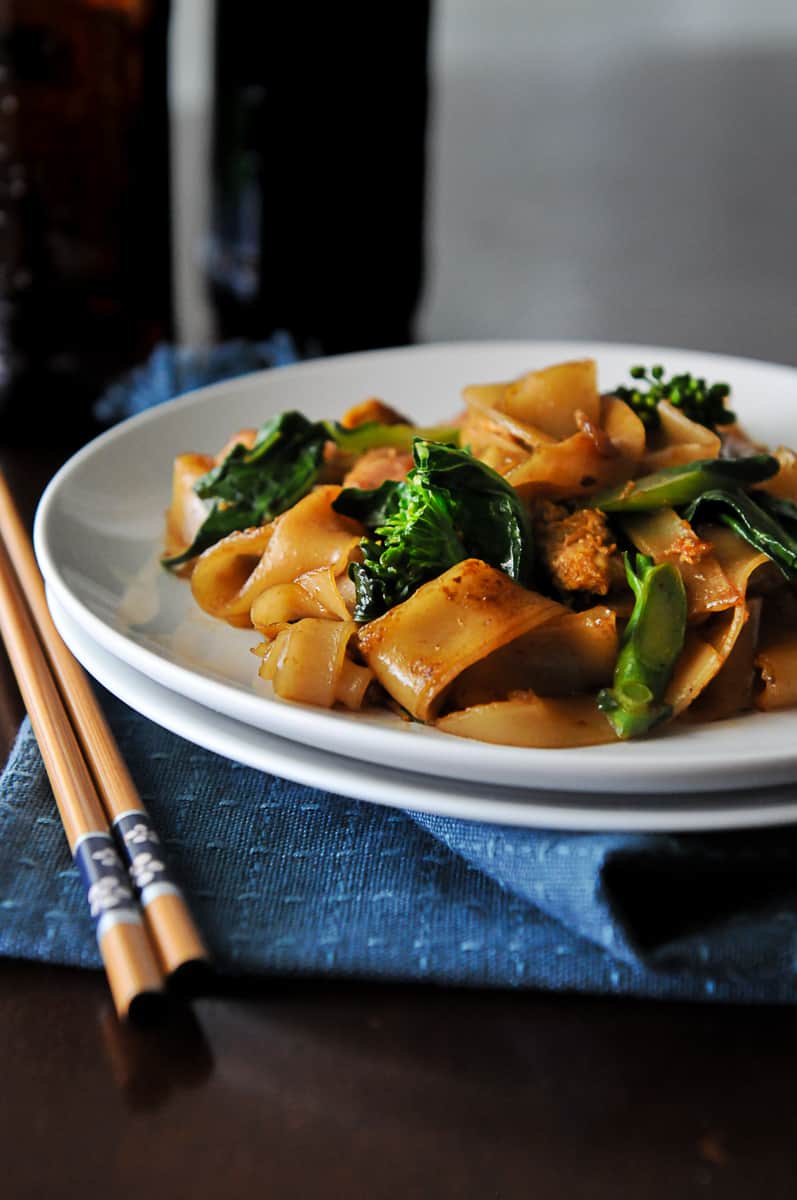
Pad See Ew with Chicken is a classic Thai dish of wide rice noodles stir fried with sweet soy sauce, Chinese broccoli, eggs, and chicken. On the streets of Thailand and in Thai restaurants throughout the world, Pad See Ew is stir fried over super high heat with flames all around the wok, giving the dish a wonderful charred, smoky aroma.
This popular Thai noodle dish is fairly mild in flavor, making it a great introductory dish for kids and others who aren't familiar with bolder Thai flavors. It's also a great dish to make at home, as it doesn't require many ingredients and results in a satisfying one-plate meal with noodles, protein, and green vegetables included.
Jump to:
What does Pad See Ew mean?
"Pad" is the Thai word for stir fry. "See Ew", pronounced see you, is the Thai word for soy sauce. Put together, Pad See Ew refers to this popular noodle dish that is stir fried with soy sauce. When served with chicken as the main protein source, this dish is known as Pad See Ew Gai. "Gai" means chicken in Thai. To learn the meaning of more Thai culinary words, please see How to Interpret a Thai Menu.
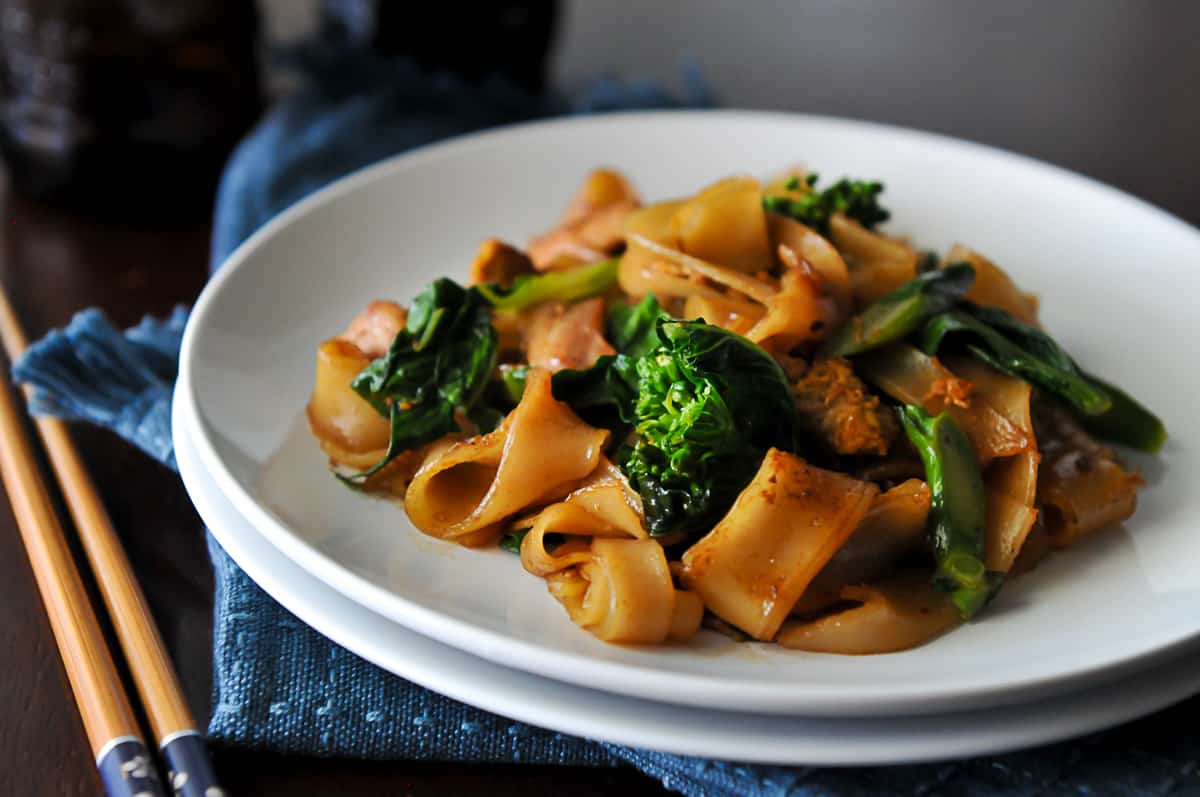
The Sauce
The wonderful flavor of Pad See Ew comes mainly from the sauce that coats the noodles. It is composed of two different kinds of soy sauces: thin soy sauce and dark sweet soy sauce. In this recipe, oyster sauce, vinegar, and sugar round out the sauce and add another dimension besides saltiness. All of these ingredients should be mixed together before cooking so that you can add them to the hot wok quickly.
- Thin soy sauce: Known as "see ew cow" or white soy sauce in Thai, this is the main soy sauce used in Thai cooking. It is mainly salty, with a rich umami flavor not found in Chinese or Japanese soy sauces. The regular version or mushroom variety both work great in this recipe.
- Sweet dark soy sauce: This soy sauce is thick in texture and dark brown in color. It is salty, but also has a molasses-like sweetness to it. If you are unable to find it in your local Asian stores, it can be purchased online. The dark soy sauce variety (known as black soy sauce rather than sweet dark soy sauce) will also work in this recipe, although it will be slightly less sweet.
- Oyster sauce: Oyster sauce adds a more rounded flavor to the sauce. A Thai brand (linked) is highly recommended to provide the correct flavor.
- White Vinegar and Sugar: Vinegar and sugar help to add a little more dimensionality to the sauce.
The Main Ingredients
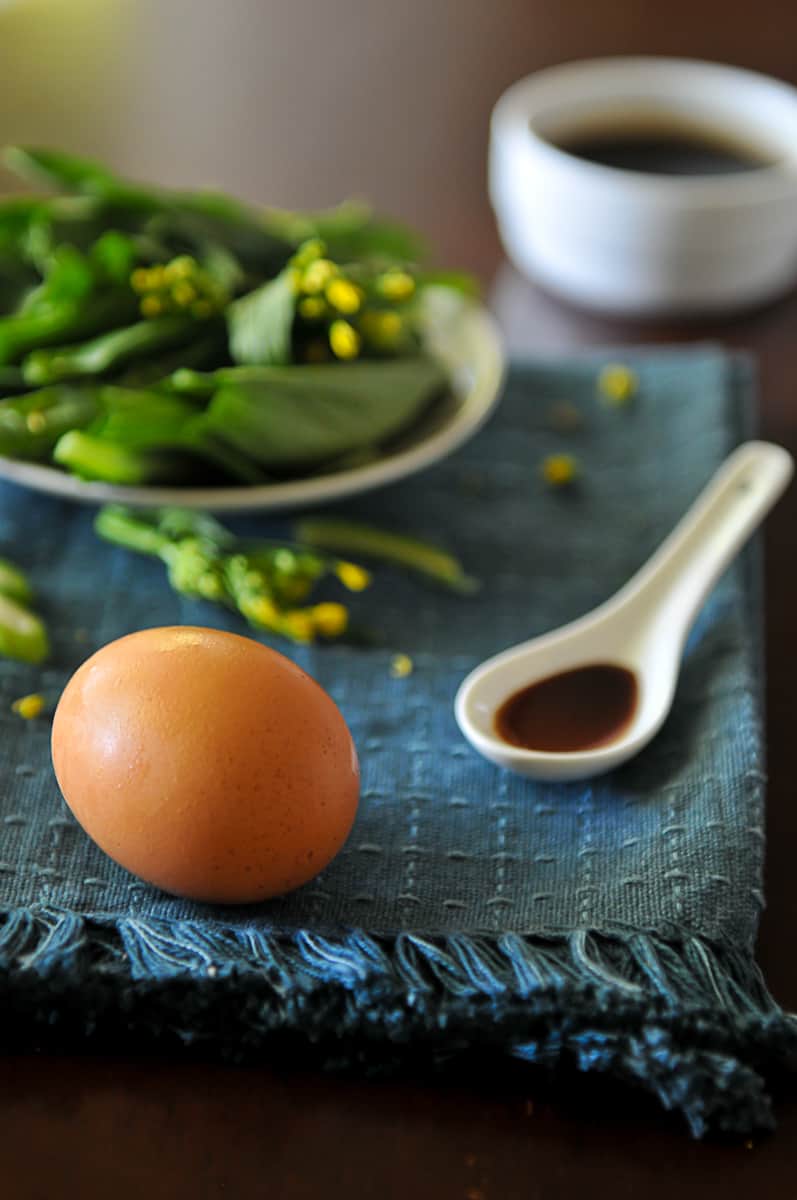
Pad See Ew is traditionally made with wide rice noodles, egg, Chinese broccoli, and a protein of your choice. For Pad See Ew with Chicken or Pad See Ew Gai, chicken is the main protein source.
- Wide rice noodles: Known as "sen yai" in Thai, wide flat rice noodles are preferred for Pad See Ew. They can usually be found fresh in pan Asian markets such as Ranch 99. If you can't find them fresh, you can alternatively rehydrate dried noodles, although this will add another level of complexity to making the dish correctly. See below for instructions on how to prepare the rice noodles for cooking.
- Chicken: Pad See Ew can be made with your choice of protein, from chicken, pork, beef, or shrimp to tofu or a plant-based meat alternative. You can also leave the main protein source out altogether, if you like. For Pad See Ew Gai, chicken should be used, as Gai means chicken. Prepare the chicken by slicing into thin, bite-sized pieces against the grain.
- Garlic: Chop finely and sauté until golden brown.
- Chinese broccoli: Known as "gai lan" in Chinese and "kana" in Thai, this leafy green vegetable provides a slight bitter taste that counterbalances the slight sweetness of the sauce. Prepare it by washing thoroughly then cutting the leaves from the stems. The leaves can be chopped coarsely and the stems can be sliced very thinly on the diagonal for faster cooking. If you can't find Chinese broccoli near you, regular broccoli can be substituted.
- Egg: One egg is scrambled into the noodle dish while cooking. Push the noodles and other ingredients to the side, then add the egg and scramble in the blank space of the wok. Once the egg is mostly done, it can be incorporated into the dish.
How to Prepare Rice Noodles for Pad See Ew
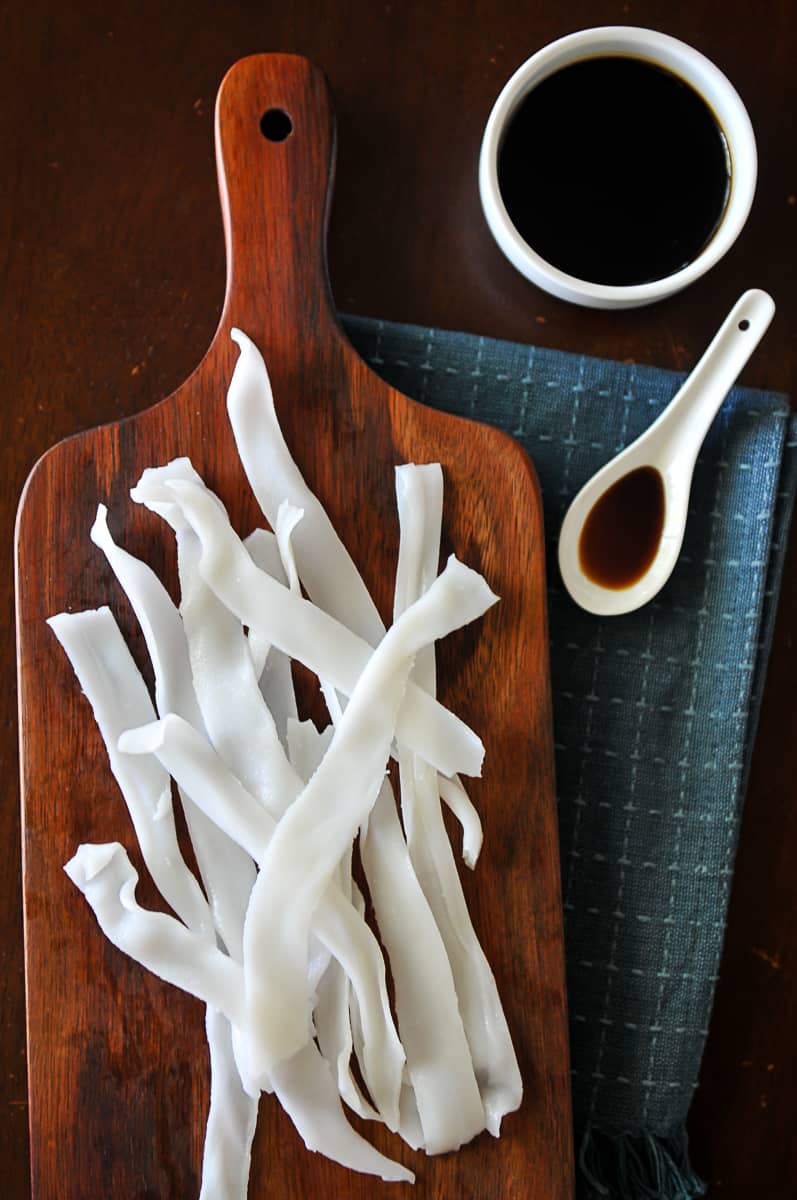
FRESH NOODLES: Fresh rice noodles are preferred for making Pad See Ew. They are often available near, but not in, the refrigerated section of Asian markets. Once purchased, fresh rice noodles can be kept on the countertop for a day or two without molding. If they are not used in this timeframe, they can be refrigerated for up to 4-5 days. However, be warned that they will harden in the refrigerator.
Once you are ready to cook Pad See Ew, take the fresh rice noodles out of the package and separate each noodle by hand. Do your best to keep them in long strands. If they have hardened, it's helpful to place them in a pot of simmering water for 30-60 seconds to loosen the noodle strands.
DRIED NOODLES: If you are not able to find fresh rice noodles, you can use dried noodles. I have found that rehydrating dried rice noodles by placing them in simmering water for 6 minutes works well. Other Thai chefs often recommend rehydrating dried rice noodles by soaking them in lukewarm water for 10-30 minutes. With either method, the goal is to rehydrate the noodles without cooking them so much that they are soggy or clump together once stir fried.
Instructions
- Prepare the Sauce: Mix all of the sauce ingredients together in a bowl. The sugar will dissolve quickly with just mixing, heating is not required.
- Prepare the Noodles: If using fresh rice noodles, use your fingers to break the noodles apart into individual strands. If they have become hard after storing in the refrigerator, you can blanch them in simmering water for several seconds to help them to separate. Dried rice noodles should be rehydrated following the above directions.
- Cook the Chicken: Add oil to your wok and heat over high heat. Stir fry until golden brown, then add the chicken and stir fry until cooked through.
- Scramble the Egg: Push the garlic and chicken to the side of the wok. Add a bit more oil to the middle of the wok, wait for it to heat up, then scramble the egg in that space. Push all ingredients to the side of the wok.
- Cook the Noodles: Add the prepared rice noodles and prepared sauce. Stir fry until the noodles are completely coated with the sauce, then mix the other ingredients in with the noodles. Add the Chinese broccoli and allow to cook until the leaves are wilted and stems are tender. During this time, let the noodles sit for a minute or so without stir frying so that they can achieve a nice char.
- Serve: Take the wok off the heat and immediately transfer to a serving plate. Serve with a set of personal condiment options (see below).
NOTE: A gas stove is pretty much necessary to achieve the smoky, charred flavor that's come to be associated with Pad See Ew. It is very difficult to get this characteristic flavor using an electric burner.
How to Serve Pad See Ew
In Thailand, Pad See Ew is served at the table with several condiment options. This is so that diners can customize the noodle dish to their own preferences. Prik nam som (vinegar with chili peppers), nam pla prik (fish sauce with chili peppers), sugar, and ground white pepper powder are common options.
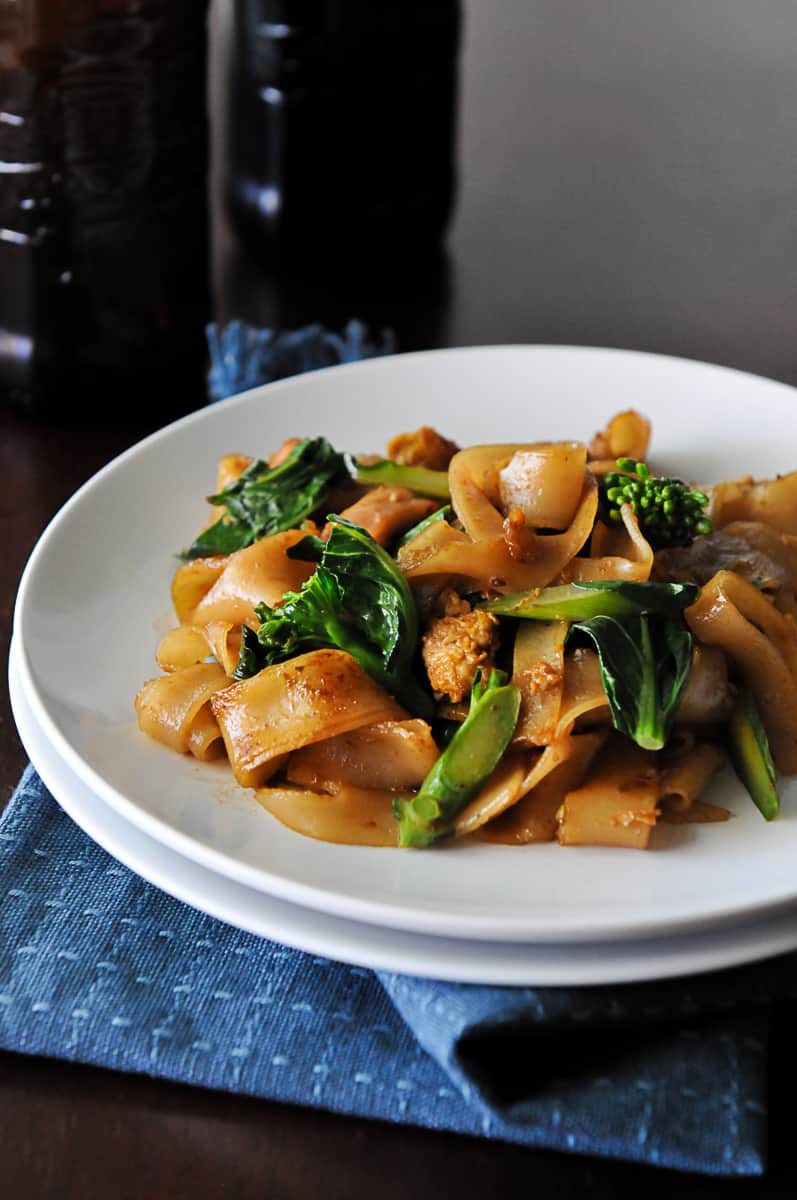
Pad See Ew vs Pad Thai
Pad See Ew and Pad Thai are both very popular Thai noodle dishes. They are both dishes of stir fried rice noodles, but that's about where the similarities end.
Pad See Ew uses wide rice noodles seasoned with a slightly sweetened soy sauce mixture. It is made of just a few ingredients, including a protein of your choice, egg, and Chinese broccoli. Pad Thai is made with medium thickness rice noodles seasoned with a sweet and sour sauce. It is traditionally made with numerous ingredients including garlic, shallots, salted radish, fried tofu, shrimp or dried shrimp, egg, bean sprouts, garlic chives, and roasted peanuts.
Pad See Ew vs Drunken Noodles
Pad See Ew and Pad Kee Mao (Drunken Noodles) have more in common. Both dishes utilize wide rice noodles seasoned with a soy sauce mixture. The main difference is in the ingredients. Pad See Ew is fairly mild and traditionally made with a protein of your choice, egg, and Chinese broccoli. Drunken noodles is supposed to be much spicier. It includes several Thai chili peppers, large red chili peppers, young green peppercorns, and holy basil leaves as well as a protein of your choice and baby corn or other vegetables.
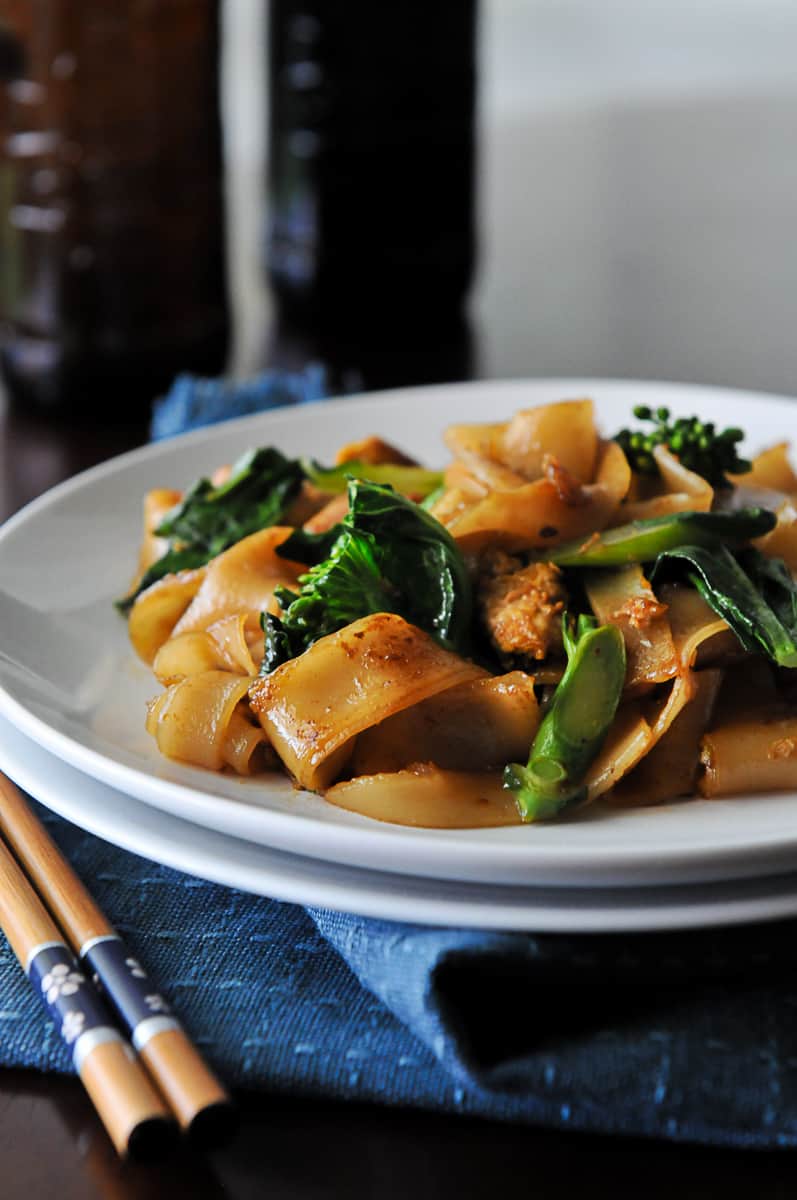
Pad See Ew with Chicken is one of my favorite street food options when in Thailand. I love being able to recreate it from the comfort of my own home. I hope this helps you to make a delicious plate of Pad See Ew in your own kitchen as well!
Recipe

Pad See Ew with Chicken | ผัดซีอิ๊วไก่
Ingredients
- 8 ounces fresh wide flat rice noodles
- ½ cup chicken skinless, boneless, sliced in bite-sized pieces
- 2 cloves garlic chopped finely
- 2 cups Chinese broccoli chopped coarsely (with stems sliced thinly on diagonal)
- 1 egg
- 2 Tablespoons sweet dark soy sauce
- 2 Tablespoons oyster sauce
- 2 teaspoons thin soy sauce
- 2 teaspoons white vinegar
- 2 teaspoons sugar
Instructions
- Prepare your sauce by mixing the sweet dark soy sauce, oyster sauce, thin soy sauce, vinegar, and sugar together. Set aside.
- Prepare your rice noodles. If using fresh noodles, use your fingers to separate each noodle into individual long strands. If they have become hard, you can place them in simmering water for 30-60 seconds to help loosen the strands. If using dried noodles, rehydrate them in simmering water for 6 minutes, until each noodle is cooked and separate but not mushy.
- Add a bit of oil to your wok and heat it over high heat. Add the garlic and saute until it's almost golden brown. Then add the chicken and saute until it's cooked through.
- Push the garlic and chicken to the side of the wok. Add a little more oil and once it's hot, crack an egg and scramble it in the middle of the wok.
- Push everything to the side and add the rice noodles and sauce you prepared earlier. Stir fry the noodles with sauce until all of the noodles are coated with the sauce. Then mix everything together.
- Next add the Chinese broccoli and cook until the leaves are wilted and stems are tender. During this time, let the noodles sit for a minute or so to get a nice char on them. Once done, take off the heat and serve immediately!
Notes
- This recipe will make 2 servings at a time. I do not recommend making more than this at one time, as the noodles are more likely to clump together if there's too much in the wok. You can prepare the ingredients for several servings and make them one after another in the same wok.
- Pad See Ew is best eaten fresh out of the wok. The longer it sits out, the more likely the rice noodles are to clump together.






Ncz
This is soo good and tastes just like the best pad see ew I’ve ever had at Cholada Thai beach cuisine.
admin
So glad to hear it!
Kelly
I realize this recipe is old and not sure if you even update this blog, but wanted to report that I've made this a few times since summer and my family loves it. So thanks so much!
admin
So glad to hear that, Kelly!
val
Just in case you get notification about comments in older posts, a question:
I have made my own sweet soy sauce before for an Indonesian dish, and it turned out fine. I was making the vegetarian version of pad see-ew last weekend, and I had purchased some Healthy Boy black soy sauce, so I used that to make my sweet soy (just simmered with sugar). Was that a mistake? Should I have used thin soy sauce to make the sweet soy sauce? I have a great Thai market in my neighborhood, but I prefer to avoid ingredients like sodium benzoate and the like, so I am trying to balance authenticity with my own standards for food ingredients. I think maybe I just don't really like dark soy, but I have never noticed it being so pronounced in the takeout I get from Thai restaurants. Any clue on if sweet soy is made with thin or dark soy?
Chelsea Henderson
I made this Pad See Ew this weekend! It was so delicious, we ate every single bite. I made a few tweaks based on our preferences, like I doubled the sauce and added another egg just because, why not! We LOVED it. I was not able to find the Chinese Broccoli at my local Asian mart so I substituted with just regular broccoli. Thanks for sharing! I love all your pictures and recipes. How do you take such professional and aesthetically beautiful pictures? Also - my husband and I spent two weeks in Thailand for our honeymoon this past December and just fell in love with the food, culture, people, etc. I would love to move there, specifically Koh Samui! Happy Monday and I look forward to trying more of your recipes!
McKenna
Can I use a saute pan for this if I don't own a wok?
Rachel
You could certainly try it. The key is to use a pan that can get super hot, so that the noodles take on a charred flavor...
Alana
I am making this for 4 people tonight, should i double the recipe? or does this recipe make a decent amount?
Rachel
Hi Alana,
This recipe serves two. I'd recommend making it in two batches, if you'd like to make enough for four, so that the noodles can get a nice char on them by sitting at the bottom of the wok.
Best,
Rachel
grace
Rachel,
glad I found this recipe, but I am having a hard time finding the ingredients since we are limited with asian grocery stores. Can I use dried flat noodle instead of fresh? Do you have any pictures of the packaging - this may help. Also, what is the chinese broccoli normally called in asian stores? Thank you for sharing!
Rachel
Hi Grace! Chinese broccoli is often referred to as "gai lan". It's better to find fresh noodles for this recipe, if you can. There are many different brands with different packaging, depending on the local provider, but the store owner may be able to point you in the right direction. I bet you could use dried noodles as a last resort, but they will require quite a bit more effort to achieve the right texture.
Christo
If I omit the egg does it impact flavor much?
Rachel
Hi Christo, you can make pad see ew without egg. It won't be exactly the same, but the main flavors should still be intact.
Wendy
This sounds good and I'll try it. Also have the Ho Motok try. I read about this recipe in Tales of a Female Nomad (Rita Goden Gelman) and looked it up and and found you!
One comment from an old travel weary foodie:
Never saute your garlic before your meat as it will burn. Fry your meat first, then add the garlic. If garlic is permitted to burn it will give a nasty flavour to your dish.
Pearl Tran
I've never frozen meals much; how do you usually cook/reheat the noodles after freezing them?
Rachel
Hi Pearl, you can use the microwave to reheat the noodles. Frozen and reheated noodles aren't quite the same as if the pad see ew is made fresh, but it works if you're in the mood for a quick dinner.
Jo
I have to comment on how much I LOVE this dish - it is my go to meal and I have probably made it around 10 times and it is on the menu again tonight 🙂
Rachel
So glad to hear, Jo!
Stephanie
This was so delicious! I made this tonight for my family. I did make some minor adjustments. I used shrimp instead of chicken and added green onion, carrot and snow peas and it was so tasty. I also did not have sweet soy sauce so I made my own using brown sugar and dark soy. It was a hit with everyone. I will definitely be making this again! Thanks so much for sharing!
not the best chef
Thanks for sharing this simple recipe..my all time favorite thai dish